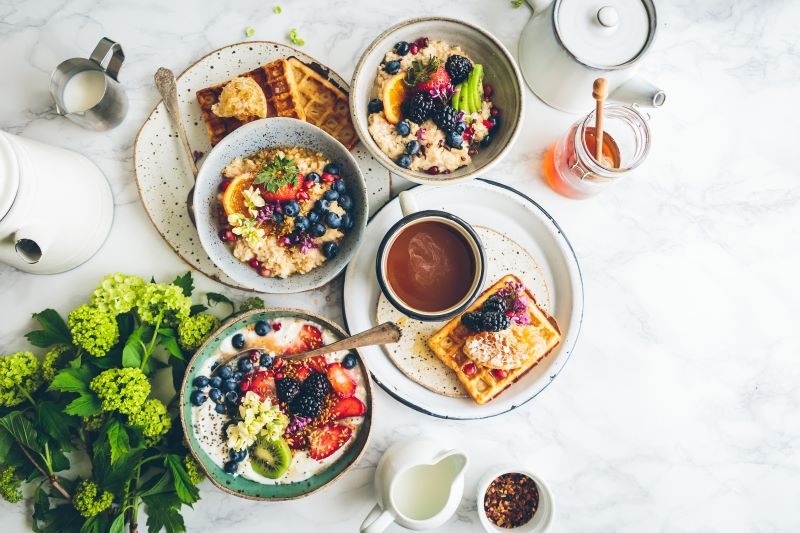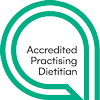Gentle nutrition – a non-diet approach to eating
This is the final post in a 10-part series looking at the principles of Intuitive Eating. The previous post in this series was on movement – feel the difference
If you’ve ever searched Intuitive Eating on social media or Google, you may have seen images of people eating donuts or ice cream and messages about eating whatever you want and, like many other people, been left with the impression that this is what Intuitive Eating is all about. Two of the biggest misconceptions about Intuitive Eating are that it’s just eating what you want, and that it is anti-nutrition and anti-health. The truth is that Intuitive Eating is more than just seeking satisfaction and enjoyment in eating (even though this is important!). And, moving away from rigid diet rules is actually pro-health and pro-nutrition because doing so helps you create a positive relationship with food that allows you to adopt sustainable, health-promoting habits rooted in self-care.
In this post, I answer some common questions and concerns people have about gentle nutrition in Intuitive Eating, what it looks like and how you can start practising it today.
Why is gentle nutrition the last of the Intuitive Eating principles?
People are often confused when they realise that nutrition is the last principle of Intuitive Eating because they really struggle to decide what to eat when they aren’t following a diet plan. And that’s precisely the reason why it needs to be the final principle of Intuitive Eating. If you try to focus on gentle nutrition before you’ve worked through the other principles of Intuitive Eating, even gentle nutrition advice can feel like just another diet. Working through the other principles of Intuitive Eating first lets you approach nutrition with a new, open perspective, not a dieting one. Here is a quick reminder of the other 9 principles:
- letting go of the diet mentality.
- making peace with food and letting go of the idea of “good” and “bad” foods and being able to eat without guilt.
- learning to tune into and trust your body’s hunger and fullness
- challenging your inner food police to let go of external food rules. It’s only after you remove guilt and shame from your diet, that you are free to tune into your body’s wisdom (the thoughts, feelings, beliefs and physical sensations your body sends you).
- exploring what food satisfaction means for you and how different foods make you feel physically.
- diversifying your emotional coping toolbox so that you have a variety of tools to cope with your emotions, that include food.
- learning to respect your body because if you are at war with your body, it’s hard to be at peace with yourself and with food.
- moving joyfully– and uncoupling movement from weight loss.
Mastering these principles first allows you to nourish yourself from a place of self-care, not self-control. So, if you are at the beginning of your Intuitive Eating journey, I recommend putting this principle to one side for a time while you work on the other 9 principles of Intuitive Eating. Most of these are about tuning into your body’s inner wisdom (the thoughts, feelings, beliefs and physical sensations your body sends you). Gentle nutrition builds on the ability to tune into your body’s wisdom by incorporating your nutrition knowledge, while still respecting your food preferences.
Why gentle nutrition?
You might also be wondering why the last principle is referred to as gentle nutrition. The word “gentle” has been added to differentiate food choices made as an intuitive eater from food choices made through a diet culture lens. The word “gentle” reflects the idea that nutrition is not rigid, restrictive or extreme in Intuitive Eating. Instead, it’s flexible, forgiving, sustainable and balanced. In diet culture, nutrition is black-and-white – there are lots of food rules that if broken can lead to intense feelings of guilt and shame. Gentle nutrition, on the other hand recognises you as the expert of your body, and gives you the flexibility to choose what works best for you.
I’m worried I won’t eat healthily
Asking the question whether you will eat healthily (or not) reflects a fear many people have —that eating intuitively means a food free-for-all. It’s ironic that this is one of the most common questions people have, because it’s actually the food restriction characteristic of dieting that can lead to out-of-control eating as the pendulum swings continuously from one extreme to the other (that is, from restriction to out-of-control eating). Also, the science shows this is not what happens. A 2021 meta-analysis showed, for example, that intuitive eating is associated with improved nutrition and eating a wider variety of foods and eating more fruit and vegetables.
Trying to eat “perfectly” can lead you further away from health
When it comes to health, nutrition is a small piece of a much bigger puzzle. Despite what diet culture would have you believe, there is so much more to your health than eating the “right” types and amounts of food (and moving your body). Nutrition (and movement) are just two of many factors that influence our health, which include the social determinants of health, genetics, and many more. Unfortunately, reducing health to nutrition and movement has led many people to become increasingly anxious about the food they select. This excessive worry can lead to an unhealthy obsession with eating “perfectly”. Often that looks like eating a limited range of foods with the result that dietary variety is reduced – something we know doesn’t promote overall health. The bottom line is that there is no “perfect” way of eating. But there are a few habits that stand up to scientific scrutiny and have stood the test of time (which we will get to shortly).
What does gentle nutrition look like?
Gentle nutrition is choosing foods that taste good and feel good in your body while also honouring your body’s wisdom (and using your nutrition knowledge). You can think of it as being the sweet spot at the intersection between nutrition knowledge, and tuning in to your body’s cues (hunger, fullness, emotions, what foods sound good in the moment and how food tastes and feels in your body). Gentle nutrition is therefore going to look different from person to person. In other words, as the expert of your body, you get to decide what gentle nutrition looks like for you.
In Intuitive Eating, nutrition knowledge refers to nutrition science that has stood the test of time (and scientific scrutiny). For example, we know that carbohydrate-rich foods are an important source of energy for our brain and muscles. We know that eating enough fibre-rich foods helps prevent constipation. We know we need to drink a certain amount of fluid each day to stay hydrated.
How can I practise gentle nutrition?
Since gentle nutrition looks different for everyone and there are no rules (unlike dieting), there’s also no “right” or “wrong” way to “do it”. Which can make it seem all the more challenging. So, here are three tips to help you get started:
Variety is the spice of life
Food variety is a key concept in gentle nutrition. Here’s why:
- Varying what we eat means more food enjoyment which in turn means more satisfying food experiences.
- More variety means we’re more likely to get the nutrients our body needs and
Not only does variety make eating more interesting and enjoyable, it’s also biologically helpful because it means our bodies are more likely to get all the nutrients they need. Different foods contain different nutrients, so when we eat a range of different foods (not just a range of fruit and vegetables, but also different sources of foods containing protein, fat and carbohydrate), we’re more likely to get the nutrients our body needs.
- More variety means greater gut microbiota diversity
Recent research suggests the more diverse our diet is, the more diverse our gut microbiota is (that’s the community of bacteria and other microbes that live in our gut, some of whom contribute to our overall health by making vitamin K, contributing to our immunity and more). Different gut bacteria prefer different types of food (or components of food) to metabolise, so eating a variety of foods means greater gut microbiota diversity which can have potential health benefits for us.
Focus on addition, not subtraction or substitution
Weight loss advice focuses on restriction – how to eat less, limit or not eat certain foods, and swapping ingredients for “healthy” ones leading to less satisfying eating experiences. In Intuitive Eating, all foods fit, and the emphasis is on adding, not subtracting from your eating experience. To get you started with this:
- Begin by asking yourself (and maybe making a list of) what foods and meals taste good to you and feel good in your body.
- Consider what you can ADD to the meals you like eating, not subtract (or replace with something you find less tasty and less energising). Some examples might be adding nuts or nut butter to your breakfast cereal, adding avocado, nuts and seeds to a salad.
Notice how foods make you feel
Practising gentle nutrition is noticing how foods make you feel because Intuitive Eating is about respecting your body – and that includes nourishing it adequately with foods that not only taste good, but also make you feel good. What does that mean exactly? It means that some foods might feel better in your body than others. For example, you might like how a certain food tastes, but you know when you eat it, you will experience some bloating and gas. This may or may not be enough of a reason to avoid or limit how much you eat of this food (see my word of caution that follows). When you think about how a food makes you feel, don’t forget to consider body, mind and soul. For example, eating your mum’s favourite chicken soup when you have a cold, might feel comforting. There may also be foods you know you can eat a little of and you will feel fine, but if you have more, you won’t feel good. Learning what foods feel good in your body (and which don’t) may, at first, require paying a bit more attention to how your body feels after eating. This is part of the process of getting to know your own body. A word of caution here: it can be very challenging to differentiate between what truly doesn’t make you feel good and what you think doesn’t make you feel good. For example, it’s very easy to mistake bloating after eating a certain food with bloating that is the result of disordered eating or an eating disorder. This can be very complicated and is worth unpacking with an intuitive eating dietitian specialised in disordered eating and eating disorders.
How do I know if I am ready to practise gentle nutrition?
Not everyone reading this may be ready for gentle nutrition. You may need to focus on healing your relationship with food first, which requires putting nutrition aside for a time. That is absolutely OK – there is no rush to get to this point!
If you’ve been practising the other Intuitive Eating principles for a time, and think you could be ready for gentle nutrition, try asking yourself these questions first which can help you differentiate between practising nutrition from a place of self-care versus self-control:
- Do my behaviours feel balanced, permissive, flexible and sustainable, or do they feel rigid, restrictive, controlling and extreme?
- Do I feel extreme guilt or shame after eating certain foods or a certain amount of food?
- Am I still feeling the need to compensate for eating a certain food or amount of food by moving more?
- If there was no chance these behaviours would help me lose weight, would I still engage in them?
Remember, if you have had a long and fraught relationship with food, it may take some time to develop a healthier relationship with food. Just come back to this principle when the timing feels right for you.
Short and sweet
Food matters, but there is no “perfect” way to eat. In fact, trying to eat “perfectly” through a diet culture lens can actually move you further away from health. Moving away from rigid diet rules is actually pro-health and pro-nutrition because doing so helps you create a positive relationship with food that allows you to adopt sustainable, health-promoting habits rooted in self-care. Gentle nutrition – the final principle of Intuitive Eating – builds on the ability to tune into your body’s wisdom by incorporating your nutrition knowledge, while still respecting your food preferences.
Ready to take the next step? Contact me and request a complimentary call to find out more about Intuitive Eating and how it can help you truly nourish yourself – body, mind and soul.






